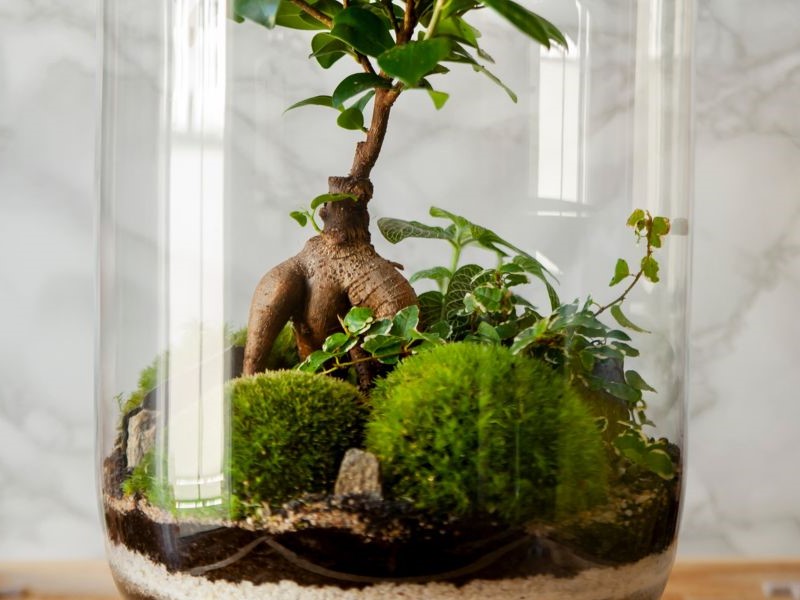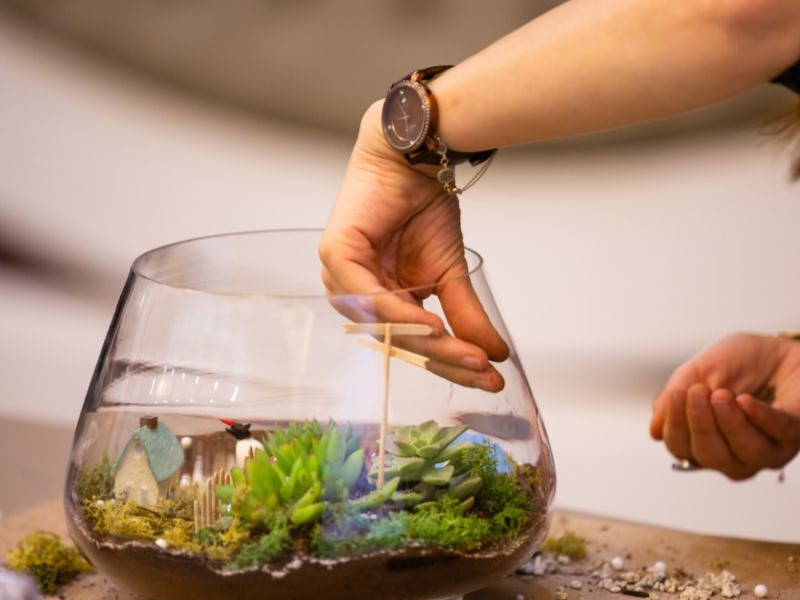Have you ever heard of a terrarium—a tiny ecosystem enclosed in glass? It’s like having a piece of nature neatly nestled on your desk or shelf. Now, imagine infusing this miniature world with the timeless beauty of bonsai for terrarium. Sounds intriguing, doesn’t it?
In this guide, we’ll walk through choosing the right bonsai, setting up an efficient terrarium, and ensuring your miniature green friends stay healthy.
Bring your curiosity, and let’s understand the magic of combining bonsai with the enchantment of terrariums!
Understanding the Concept of Terrarium Bonsai

Understanding the concept of bonsai for terrarium involves grasping the essence of two intriguing elements—terrariums and bonsai trees.
Terrariums are small ecosystems encapsulated within glass containers, featuring a combination of soil, plants, and sometimes decorative elements to create a self-sustaining environment. Enclosed in glass or jar, they form a controlled garden where plants flourish in a confined space, requiring minimal maintenance. In simpler terms, a terrarium serves as a personal snippet of nature, bringing the outdoors inside without needing an expansive garden.
Introducing bonsai into this terrarium equation, we find that these miniature trees, traditionally associated with meticulous cultivation, become an artistic addition to compact ecosystems. Tailored for limited space, miniature bonsai contributes to the aesthetics of the terrarium, creating a harmonious blend where the art of bonsai seamlessly meets the enchantment of enclosed landscapes.
Planning Your Terrarium Bonsai Setup
When preparing your terrarium for bonsai cultivation, it’s essential to consider the environment that best suits your chosen bonsai species. Terrariums generally fall into two categories: open and closed.
Open terrariums feature an uncovered or partially covered setup, allowing more airflow and evaporation. Feature an uncovered or partially covered setup, allowing more airflow and evaporation.
In contrast, closed terrariums create a sealed environment with glass or plastic, fostering high humidity levels. This setup is ideal for bonsai species that thrive in consistent moisture.
Consider a container with a wider opening for open terrariums to enhance airflow. Ensure it has drainage holes to prevent water buildup. The soil mix should encourage drainage and aeration, fostering a healthier environment for bonsai that prefer drier conditions.
Opt for a container with a clear lid or walls in closed terrariums to maximize light exposure. Adequate drainage is still essential to prevent overwatering. The soil mix should retain moisture without becoming waterlogged. A combination of potting soil, Akadama, and sphagnum moss provides the necessary balance for bonsai to thrive in higher humidity.
Selecting the Right Bonsai Species

When venturing into terrarium bonsai, it’s crucial to understand the key characteristics that make a bonsai species well-suited for this miniature environment. Firstly, consider the size. Opt for bonsai varieties that naturally stay small, ensuring they fit harmoniously within the limited space of a terrarium. Look for species with compact foliage, contributing to the overall visual balance and preventing overcrowding.
Another essential characteristic is adaptability. Choose certain plants that thrive in the specific conditions of a terrarium, including the humidity levels created within the glass enclosure. Lastly, consider how the trees grow. Select bonsai terrarium trees with a slower growth rate to minimize the need for frequent pruning and maintenance.
Here are some of the bonsai species you can add to your terrariums:
1. Jade Plant (Crassula ovata)
- Characteristics: Compact size, succulent nature, and minimal maintenance requirements.
- Why it suits: Perfectly fits the limited space of a terrarium, thriving in controlled environments. Its succulent leaves store water, making it resilient to occasional neglect.
2. Dwarf Ficus (Ficus retusa)
- Characteristics: Ficus ginseng has small leaves, adaptable to different light conditions.
- Why it suits: Maintains a petite size, making it well-suited for the balanced environment within a terrarium. Its adaptability to light conditions adds to its versatility.
3. Chinese Elm (Ulmus parvifolia)
- Characteristics: Fine branches, small, vibrant leaves.
- Why it suits: Adds aesthetic appeal to the miniature landscape with its fine foliage. The Chinese Elm is adaptable and maintains a moderate growth rate.
4. Dwarf Juniper (Juniperus procumbens ‘Nana’)
- Characteristics: Compact size, needle-like leaves.
- Why it suits: It is well-adapted to confined spaces and maintains a small form suitable for terrariums. Its needle-like leaves contribute to a classic bonsai appearance.
5. Boxwood (Buxus):
- Characteristics: Small leaves, dense foliage.
- Why it suits: With its compact growth habit, boxwood is well-suited for terrariums. It responds well to pruning, allowing you to shape it according to your preferences.
6. Fukien Tea (Carmona microphylla)
- Characteristics: Small leaves, delicate white flowers.
- Why it suits: Compact size, intricate branching patterns, and adaptability make it an elegant addition to confined terrarium spaces. Its responsiveness to pruning provides creative possibilities for shaping and maintenance.
7. Bald Cypress (Taxodium distichum)
- Characteristics: Feathery foliage, unique trunk features.
- Why it suits: Its seasonal changes, including vibrant fall colors, bring a dynamic and natural element to the miniature ecosystem.
8. Portulacaria Afra (Elephant Bush)
- Characteristics: Small, succulent leaves, resilient to dry conditions.
- Why it suits: Thrives in the limited space of a terrarium, with its water-storing leaves making it a hardy choice, even if watering becomes irregular.
9. Dwarf Schefflera (Schefflera arboricola)
- Characteristics: Compact size, palmate leaves.
- Why it suits: Its more diminutive stature and elegant foliage make it ideally suited for a terrarium, bringing a touch of tropical charm to a confined setting.
10. Bougainvillea
- Characteristics: Colorful bracts, thorny branches.
- Why it suits: Hailing from tropical regions, Bougainvillea adds a vibrant burst of color to your terrarium. Its ability to thrive in warm, humid conditions makes it a delightful addition if you have a collection of tropical plants.
11. Dwarf Pomegranate (Punica granatum ‘Nana’)
- Characteristics: Small, vibrant flowers, compact growth.
- Why it suits: The miniature blooms and restrained growth of the Dwarf Pomegranate add a burst of color and an ornamental touch to the terrarium, requiring minimal pruning.
Essential Tools and Materials for Terrarium Bonsai
Creating a thriving terrarium bonsai ecosystem requires a thoughtful selection of tools and materials to ensure a healthy and balanced environment.
Container
Opt for a clear glass box, jar, or bowl to offer a transparent view of your miniature landscape. Ensure the container’s size complements your bonsai’s growth and fits comfortably within the terrarium space. If available, choose a container with drainage holes to prevent water from accumulating at the bottom, reducing your bonsai’s risk of root rot.
Pruning Shears
Regular pruning helps remove dead or overgrown branches, promoting healthy growth and an aesthetically pleasing appearance.
Watering Can or Spray Bottle
A watering can or spray bottle allows you to provide the right amount of moisture, preventing overwatering or drought.
Bamboo Chopsticks or Stick
Bamboo chopsticks or a stick are handy for testing the moisture level in the soil. Insert them into it; if they come out slightly damp, it indicates the right time for watering.
Spade or Trowel
A compact spade or trowel is essential for planting bonsai and elements into the container. It also plays a crucial role in skillfully blending the soil mixture.
Small Rocks
Place a layer of small rocks at the bottom of the container to facilitate proper water movement.
Moss or Decorative Elements
Moss or other decorative elements or a ground cover can add aesthetic appeal to your terrarium. They also help retain a moist environment, especially in closed terrariums, contributing to a more stable humidity level.
Bonsai Soil Mix
A suitable soil mix is essential for proper drainage and nutrient availability. A blend of potting soil, perlite, and coarse sand creates an environment that promotes root health and overall plant terrarium vitality.
Miniature Rake
A small rake is handy for grooming the soil surface, loosening compacted soil, and creating a neat appearance in your terrarium bonsai. It’s a useful tool for maintaining the overall aesthetics.
Wire Cutters
Wire is often used in bonsai for shaping and training branches. Having wire cutters ensures you can easily adjust or remove wire without damaging the delicate branches of your terrarium bonsai.
Care Guide for Bonsai for Terrarium

Ensuring the well-being of bonsai terrariums demands a thoughtful approach to various factors.
In terms of lighting, opt for a location without facing the full sun, just enough to provide bright, indirect light without the risk of overheating. Temperature control within the terrarium is crucial, aiming for a consistent range between 60°F to 75°F (15°C to 24°C), respecting the temperature preferences of individual bonsai species. Furthermore, given the inherently humid environment of terrariums, monitor and adjust humidity levels accordingly, and employ misting or humidity trays as needed.
In terms of watering, be mindful of proper drainage to prevent waterlogging, adjusting the watering frequency based on the specific needs of your bonsai. Choose a well-draining soil mix, preferably Akadama, to support optimal growth. Regular pruning and training are essential for managing the limited space within the terrarium and maintaining the bonsai’s shape and size. Carefully select a container that complements the terrarium’s aesthetics, ensuring it allows for proper drainage.
Fertilization is crucial, with a balanced, water-soluble, or liquid fertilizer applied at half-strength during the growing season. Vigilantly monitor each bonsai for signs of stress, pests, or diseases, adjusting care practices accordingly. By attentively addressing these elements, you can cultivate a thriving and visually appealing bonsai collection within the unique environment of a terrarium.
Conclusion
In the delightful union of bonsai for terrariums, a perfect harmony unfolds—merging the art of growing bonsai with the enchantment of a glass-closed ecosystem. Paired with the timeless allure of your little tree, these carefully cultivated wonders become artistic companions within the confined landscapes of terrariums.
In exploring this guide, which serves as your ally in choosing the finest, embrace curiosity, creativity, and an appreciation for the magic that unfolds when two distinct worlds gently merge.
Whether indulging in a personal delight or seeking a unique gift, particularly a birthday gift, a bonsai for terrariums stands as a living masterpiece within the glass—an extraordinary token of admiration and wonder.
Allow your plant terrariums to flourish with the grace of the best, and revel in the marvel of the miniature masterpiece within the glass!






0 Comments